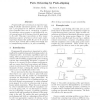Free Online Productivity Tools
i2Speak
i2Symbol
i2OCR
iTex2Img
iWeb2Print
iWeb2Shot
i2Type
iPdf2Split
iPdf2Merge
i2Bopomofo
i2Arabic
i2Style
i2Image
i2PDF
iLatex2Rtf
Sci2ools
ICRA
1995
IEEE
1995
IEEE
Parts Orienting by Push-Aligning
Programmable parts orienting is an important capability for exible automation systems. Here we study how a part grasped in an unknown orientation by a force-controlled robot can be oriented by a sequence of push-align actions against a wall followed by sensor measurements of the distance from the grasp point to the wall. This paper concentrates on three issues: planning a sequence of actions to orient a part, exploring design changes that enable the part to be oriented in fewer steps, and the e ect of shape uncertainty, due to manufacturing tolerances, on part orientability.
| Added | 26 Aug 2010 |
| Updated | 26 Aug 2010 |
| Type | Conference |
| Year | 1995 |
| Where | ICRA |
| Authors | Srinivas Akella, Matthew T. Mason |
Comments (0)

